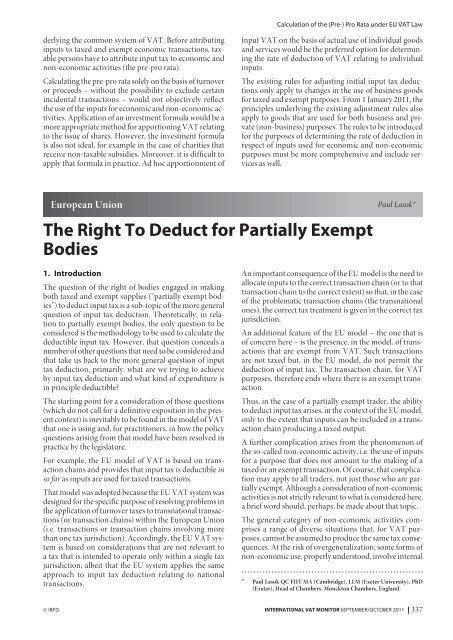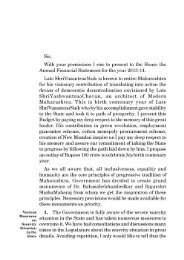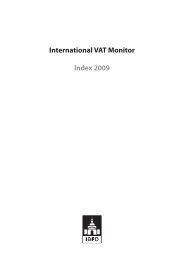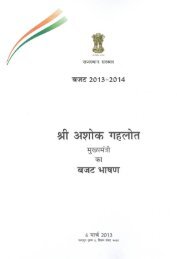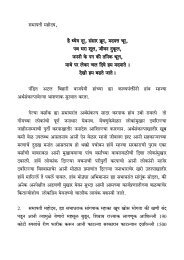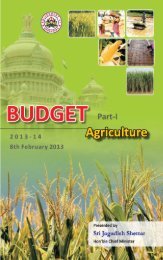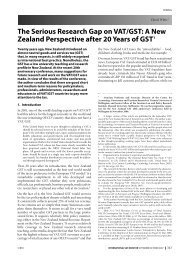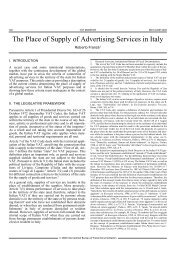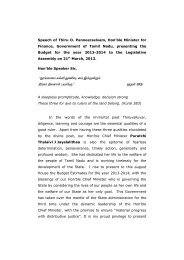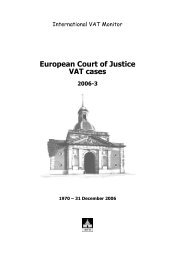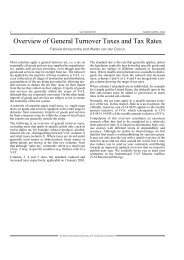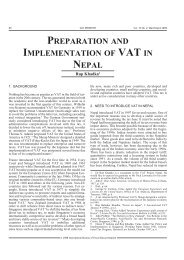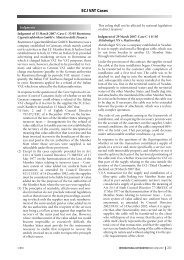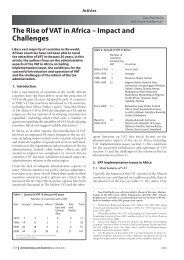Calculation of the (Pre-) Pro Rata under EU VAT Law - empcom.gov.in
Calculation of the (Pre-) Pro Rata under EU VAT Law - empcom.gov.in
Calculation of the (Pre-) Pro Rata under EU VAT Law - empcom.gov.in
You also want an ePaper? Increase the reach of your titles
YUMPU automatically turns print PDFs into web optimized ePapers that Google loves.
derly<strong>in</strong>g <strong>the</strong> common system <strong>of</strong> <strong>VAT</strong>. Before attribut<strong>in</strong>g<br />
<strong>in</strong>puts to taxed and exempt economic transactions, taxable<br />
persons have to attribute <strong>in</strong>put tax to economic and<br />
non-economic activities (<strong>the</strong> pre-pro rata).<br />
Calculat<strong>in</strong>g <strong>the</strong> pre-pro rata solely on <strong>the</strong> basis <strong>of</strong> turnover<br />
or proceeds – without <strong>the</strong> possibility to exclude certa<strong>in</strong><br />
<strong>in</strong>cidental transactions – would not objectively reflect<br />
<strong>the</strong> use <strong>of</strong> <strong>the</strong> <strong>in</strong>puts for economic and non-economic activities.<br />
Application <strong>of</strong> an <strong>in</strong>vestment formula would be a<br />
more appropriate method for apportion<strong>in</strong>g <strong>VAT</strong> relat<strong>in</strong>g<br />
to <strong>the</strong> issue <strong>of</strong> shares. However, <strong>the</strong> <strong>in</strong>vestment formula<br />
is also not ideal, for example <strong>in</strong> <strong>the</strong> case <strong>of</strong> charities that<br />
receive non-taxable subsidies. Moreover, it is difficult to<br />
apply that formula <strong>in</strong> practice. Ad hoc apportionment <strong>of</strong><br />
European Union<br />
<strong>Calculation</strong> <strong>of</strong> <strong>the</strong> (<strong>Pre</strong>-) <strong>Pro</strong> <strong>Rata</strong> <strong>under</strong> <strong>EU</strong> <strong>VAT</strong> <strong>Law</strong><br />
<strong>in</strong>put <strong>VAT</strong> on <strong>the</strong> basis <strong>of</strong> actual use <strong>of</strong> <strong>in</strong>dividual goods<br />
and services would be <strong>the</strong> preferred option for determ<strong>in</strong><strong>in</strong>g<br />
<strong>the</strong> rate <strong>of</strong> deduction <strong>of</strong> <strong>VAT</strong> relat<strong>in</strong>g to <strong>in</strong>dividual<br />
<strong>in</strong>puts.<br />
The exist<strong>in</strong>g rules for adjust<strong>in</strong>g <strong>in</strong>itial <strong>in</strong>put tax deductions<br />
only apply to changes <strong>in</strong> <strong>the</strong> use <strong>of</strong> bus<strong>in</strong>ess goods<br />
for taxed and exempt purposes. From 1 January 2011, <strong>the</strong><br />
pr<strong>in</strong>ciples <strong>under</strong>ly<strong>in</strong>g <strong>the</strong> exist<strong>in</strong>g adjustment rules also<br />
apply to goods that are used for both bus<strong>in</strong>ess and private<br />
(non-bus<strong>in</strong>ess) purposes. The rules to be <strong>in</strong>troduced<br />
for <strong>the</strong> purposes <strong>of</strong> determ<strong>in</strong><strong>in</strong>g <strong>the</strong> rate <strong>of</strong> deduction <strong>in</strong><br />
respect <strong>of</strong> <strong>in</strong>puts used for economic and non-economic<br />
purposes must be more comprehensive and <strong>in</strong>clude services<br />
as well.<br />
The Right To Deduct for Partially Exempt<br />
Bodies<br />
1. Introduction<br />
The question <strong>of</strong> <strong>the</strong> right <strong>of</strong> bodies engaged <strong>in</strong> mak<strong>in</strong>g<br />
both taxed and exempt supplies (“partially exempt bodies”)<br />
to deduct <strong>in</strong>put tax is a sub-topic <strong>of</strong> <strong>the</strong> more general<br />
question <strong>of</strong> <strong>in</strong>put tax deduction. Theoretically, <strong>in</strong> relation<br />
to partially exempt bodies, <strong>the</strong> only question to be<br />
considered is <strong>the</strong> methodology to be used to calculate <strong>the</strong><br />
deductible <strong>in</strong>put tax. However, that question conceals a<br />
number <strong>of</strong> o<strong>the</strong>r questions that need to be considered and<br />
that take us back to <strong>the</strong> more general question <strong>of</strong> <strong>in</strong>put<br />
tax deduction, primarily: what are we try<strong>in</strong>g to achieve<br />
by <strong>in</strong>put tax deduction and what k<strong>in</strong>d <strong>of</strong> expenditure is<br />
<strong>in</strong> pr<strong>in</strong>ciple deductible?<br />
The start<strong>in</strong>g po<strong>in</strong>t for a consideration <strong>of</strong> those questions<br />
(which do not call for a def<strong>in</strong>itive exposition <strong>in</strong> <strong>the</strong> present<br />
context) is <strong>in</strong>evitably to be found <strong>in</strong> <strong>the</strong> model <strong>of</strong> <strong>VAT</strong><br />
that one is us<strong>in</strong>g and, for practitioners, <strong>in</strong> how <strong>the</strong> policy<br />
questions aris<strong>in</strong>g from that model have been resolved <strong>in</strong><br />
practice by <strong>the</strong> legislature.<br />
For example, <strong>the</strong> <strong>EU</strong> model <strong>of</strong> <strong>VAT</strong> is based on transaction<br />
cha<strong>in</strong>s and provides that <strong>in</strong>put tax is deductible <strong>in</strong><br />
so far as <strong>in</strong>puts are used for taxed transactions.<br />
That model was adopted because <strong>the</strong> <strong>EU</strong> <strong>VAT</strong> system was<br />
designed for <strong>the</strong> specific purpose <strong>of</strong> resolv<strong>in</strong>g problems <strong>in</strong><br />
<strong>the</strong> application <strong>of</strong> turnover taxes to transnational transactions<br />
(or transaction cha<strong>in</strong>s) with<strong>in</strong> <strong>the</strong> European Union<br />
(i.e. transactions or transaction cha<strong>in</strong>s <strong>in</strong>volv<strong>in</strong>g more<br />
than one tax jurisdiction). Accord<strong>in</strong>gly, <strong>the</strong> <strong>EU</strong> <strong>VAT</strong> system<br />
is based on considerations that are not relevant to<br />
a tax that is <strong>in</strong>tended to operate only with<strong>in</strong> a s<strong>in</strong>gle tax<br />
jurisdiction, albeit that <strong>the</strong> <strong>EU</strong> system applies <strong>the</strong> same<br />
approach to <strong>in</strong>put tax deduction relat<strong>in</strong>g to national<br />
transactions.<br />
Paul Lasok*<br />
An important consequence <strong>of</strong> <strong>the</strong> <strong>EU</strong> model is <strong>the</strong> need to<br />
allocate <strong>in</strong>puts to <strong>the</strong> correct transaction cha<strong>in</strong> (or to that<br />
transaction cha<strong>in</strong> to <strong>the</strong> correct extent) so that, <strong>in</strong> <strong>the</strong> case<br />
<strong>of</strong> <strong>the</strong> problematic transaction cha<strong>in</strong>s (<strong>the</strong> transnational<br />
ones), <strong>the</strong> correct tax treatment is given <strong>in</strong> <strong>the</strong> correct tax<br />
jurisdiction.<br />
An additional feature <strong>of</strong> <strong>the</strong> <strong>EU</strong> model – <strong>the</strong> one that is<br />
<strong>of</strong> concern here – is <strong>the</strong> presence, <strong>in</strong> <strong>the</strong> model, <strong>of</strong> transactions<br />
that are exempt from <strong>VAT</strong>. Such transactions<br />
are not taxed but, <strong>in</strong> <strong>the</strong> <strong>EU</strong> model, do not permit <strong>the</strong><br />
deduction <strong>of</strong> <strong>in</strong>put tax. The transaction cha<strong>in</strong>, for <strong>VAT</strong><br />
purposes, <strong>the</strong>refore ends where <strong>the</strong>re is an exempt transaction.<br />
Thus, <strong>in</strong> <strong>the</strong> case <strong>of</strong> a partially exempt trader, <strong>the</strong> ability<br />
to deduct <strong>in</strong>put tax arises, <strong>in</strong> <strong>the</strong> context <strong>of</strong> <strong>the</strong> <strong>EU</strong> model,<br />
only to <strong>the</strong> extent that <strong>in</strong>puts can be <strong>in</strong>cluded <strong>in</strong> a transaction<br />
cha<strong>in</strong> produc<strong>in</strong>g a taxed output.<br />
A fur<strong>the</strong>r complication arises from <strong>the</strong> phenomenon <strong>of</strong><br />
<strong>the</strong> so-called non-economic activity, i.e. <strong>the</strong> use <strong>of</strong> <strong>in</strong>puts<br />
for a purpose that does not amount to <strong>the</strong> mak<strong>in</strong>g <strong>of</strong> a<br />
taxed or an exempt transaction. Of course, that complication<br />
may apply to all traders, not just those who are partially<br />
exempt. Although a consideration <strong>of</strong> non-economic<br />
activities is not strictly relevant to what is considered here,<br />
a brief word should, perhaps, be made about that topic.<br />
The general category <strong>of</strong> non-economic activities comprises<br />
a range <strong>of</strong> diverse situations that, for <strong>VAT</strong> purposes,<br />
cannot be assumed to produce <strong>the</strong> same tax consequences.<br />
At <strong>the</strong> risk <strong>of</strong> overgeneralization, some forms <strong>of</strong><br />
non-economic use, properly <strong>under</strong>stood, <strong>in</strong>volve <strong>in</strong>ternal<br />
* Paul Lasok QC FIIT MA (Cambridge), LLM (Exeter University), PhD<br />
(Exeter), Head <strong>of</strong> Chambers, Monckton Chambers, England.<br />
© IBFD INTERNATIONAL <strong>VAT</strong> MONITOR SEPTEMBER/OCTOBER 2011<br />
337


